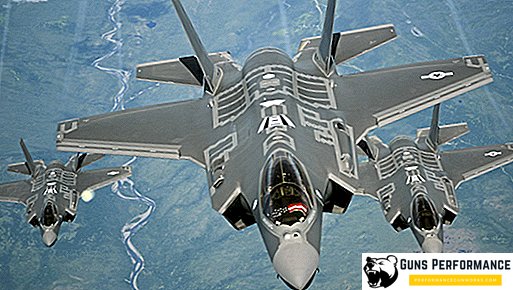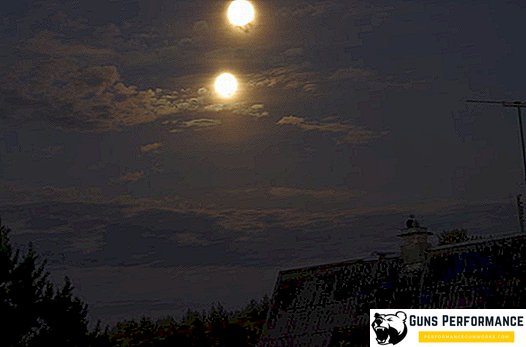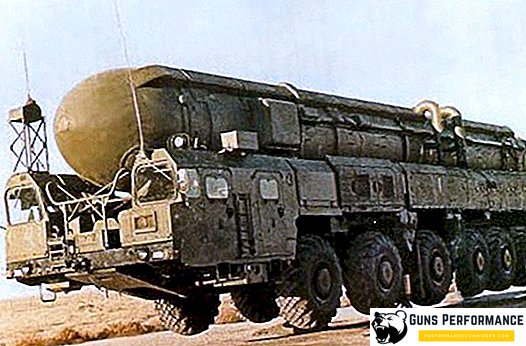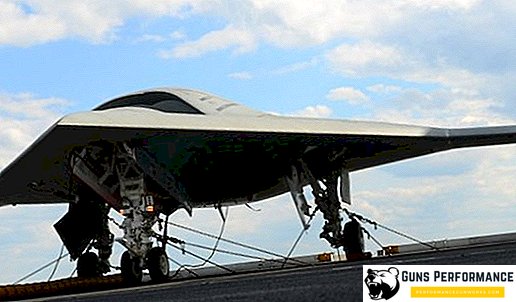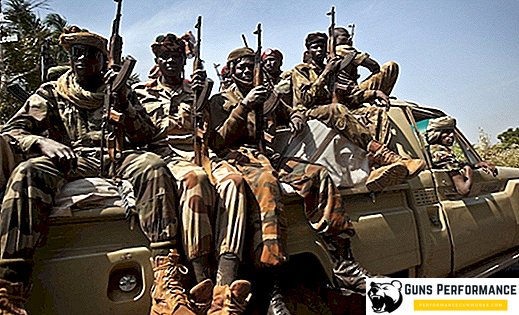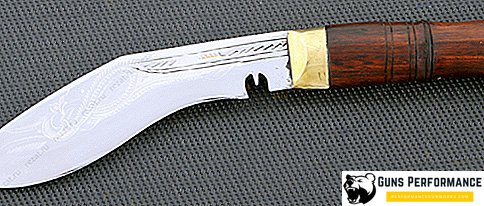
At all times, combat knives were considered weapons of these warriors. Such blades existed in different cultures, but only a small part of them has reached our days. There are among them weapons, like machetes, which can be called martial with a big stretch, since its main purpose is to cut creepers and reeds. But the Nepali kukri is a real military combat knife.
What is a kukri knife?

The history of the Kukri knife still has a lot of white spots. This massive combat knife with a curved blade, used today by the police in Nepal, in Russia is considered to be domestic economic. But even an inexperienced man in the street just one glance at the kukri is enough to understand that there is a real military weapon in front of him.
Even the national emblem of Nepal until 2006 was decorated with two kukri knives, symbolizing the traditional weapons of the Gurkha army used by them in close combat. Often there is debate about how to properly call these weapons:
- Kukri, which sounds more familiar to a resident of Russia;
- Or Khukri, on which experts of the Nepali language insist.
One way or another, both of these names denote the same subject. Its origin can be traced back to the ancient Greeks, because it was their traditional swords that most likely served as the basis for this Nepalese weapon.
The military standard of the army of Nepal clearly indicates that not all Kukri-type knives are military weapons. In the army only the following models are recognized as combat:
- Having a total length of 15 inches;
- The weight of the weapon should be about 600 grams.
The remaining models of kukri, which differ in size and weight, can be used both for ritual purposes and for agricultural work. Currently, the traditional Gurkha knife is used as a weapon by the following Nepali units:
- The armed forces of Nepal;
- Nepalese police;
- Gurkha military units of the army of Great Britain.
In addition, the Nepali knife has long been a symbol of the country for many tourists. A huge number of traditional Nepali knives are sold annually for export.
History of Kukri

The Nepalese knife is one of the most ancient types of cold arms, which has survived in its original form. Nepalese believe that these knives were at their dawn of the ages, and the first Nepalese warriors took the first samples of the kukri from the brave Macedonians. Of course, this is nothing more than a beautiful legend, since the Greek phalanx for the wild tribe of Nepalese was invulnerable, even if you believe that they once met.
In any case, drawings of weapons that look like kukri can be made from models of traditional weapons of the following peoples:
- The sword of the ancient Greeks;
- Turkish yatagan.
The blow with a curved massive blade in the form of a "wing of a falcon" is much more powerful than the same blow with a straight blade. In the Nepalese museums, the most ancient specimens of traditional knives date back to just 14th century. Although in written sources there are references from the 7th century.
The size of the ancient Kukri knife does not exceed modern counterparts. Gurkha, who had previously participated in military clashes with England, clearly demonstrated the strength of this blade - they cut off the head with one blow.
Features of the design of the Nepali blade
The Nepali fighting knife, which is a kukri, is a long blade curved inside. The blade shape is called "falcon wing". Blade kukri sharpened only from the inside. In addition to the unusual angle, the knife also has a zone hardening. Since the Nepali knife belongs to the ancient types of knives, some of its elements also have a symbolic meaning. Features of any large kukri are as follows:
- Blade kukri has zonal hardening. At the butt it is softer, and closer to the blade - harder;
- Dol is called "Shiva's sword". This is the main attribute of the kukri, which should give the weapon magical properties;
- The handle of the traditional kukri is made from the horns of a buffalo. This is not the best option, as the horn is prone to cracking;
- Rings on the handle symbolize the levels of the universe. They serve to make it more comfortable for the hand to hold a weapon, although in practice these rings may simply rub the palm to calluses;
- The edge of the blade, passing from the inside, has different angles of sharpening. This was done so that the blade could not only cut down enemies, but also perform various household tasks. Each part of the blade is used for its own purposes;
- The notch on the blade near the handle is the so-called "Shiva tooth". It must relieve metal stress during operation, preventing damage to the weapon. According to some reports, it was about this place that the gurkha’s fingers were pricked before the fight;
- On the other side of the horn handle there is a top of brass or copper, intended for hammering nails or chopping nuts. Although soft metal is still not very suitable for these purposes;
- The butt of the blade has a thickness of about 12 mm.
It is the thickness of the metal that gives the Gurkha’s combat knife such power. In this case, the cutting blows are not very effective, but the cutting - out of competition.
Sacred value kukri for gurkha

Each unusual element of a combat Nepalese knife has its own meaning. For example, the triangular shape of the blade section embodies the three gods of Hinduism. In addition, other elements of weapons denote the following:
- The blade itself, which has different angles of sharpening, symbolizes the sun and the moon;
- Dredging of metal near the handle - symbolizes the trident of the god Shiva, who in India is considered a symbol of power. This notch is called "cho" and may also have the shape of a cow’s footprint. In this case, it symbolizes the goddess Kali;
- The pommel is called the "eye of god." It should help the owner of the weapon in battle.
You need to know that modern models of kukri, which are sold in local Nepalese shops, are not always made in accordance with the sacred rules. For this reason, for a tourist who wants to touch the real legend, it is very important to study the knife for the presence of all the necessary structural elements. As for the advice of choice, the metal for knives - this is the usual spring steel, in addition, local craftsmen often save on the shank.
Now there are models that have a metal handle, with lining of wood or horn. These are not identical knives, but they are much more reliable. Kukri sheaths have compartments to accommodate two extra knives. One of them is a working tool designed for work, and the second is for editing. To fully sharpen the edge of your kukri, this knife will not help, but it will cope with correcting minor zaminov.
Kukri use in battle

Although at the beginning of the 19th century, cold arms in Europe had long ago given way to the leading position when the British army tried to seize Nepal, it had to deal with the traditional knives of the local population. Due to the fact that Nepal was a backward country, most of the Gurkas had only this weapon.
The neglect of the English soldiers to the "savages with crooked pieces of iron" was quickly replaced by respect and then horror. Even armed with outdated rifles, Gurkha soldiers, having spent all their ammunition, snatched the kukri and rushed into battle. It was at that time that legends about this ancient knife began to spread among the European population.
From the early years, the local people were trained in traditional knife fights, and the kukri was the local equivalent of a machete that every peasant had. In addition, there is information about the existence of an entire military school, called "Kukri". It is not known whether this is true or an advertising move, but people trained to wield these weapons from childhood can be really very dangerous for their enemies.
Gurkha are not exactly typical Indians, who are quite peaceful people trying to avoid violence. The traditional Gurkha, brought up in the traditional style, will avoid fighting conflict, may even run away, but if he gets a knife, he will definitely strike. After killing the enemy, he will not feel remorse, because he was so brought up.
Why do kukri in peacetime?
For residents of Nepal, the traditional kukri knife is not only a weapon. He replaces the peasants and the mountaineers of Nepal with an ax. Since many locals live in light huts, kukri is used as a construction tool that can be used to chop lianas and bamboo stalks. In addition, this tool is an element of equipment of local hunters, who cleared them trails in the jungle.
However, do not think that the same knife is used for fighting and for cutting a reed. Real military weapons will never be exploited as an agricultural tool. For this there are simpler models that do not carry a sacred meaning.
Currently, kukri are sold as souvenirs. It is these knives brought tourists from Nepal. As a rule, these are low-quality products that can only be hung on the wall. Numerous tests have proven that most of the blades are too soft, and the handles are falling apart at the very first woodwork. Although for the local army and police kukri make better quality.
If a person has the task to buy not just a souvenir, but a real work tool, then you need to look for it from local blacksmiths. In this case, the shank should be end-to-end, and better all-metal handle, with wooden or horn plates. If identity is not the main parameter, then it is better to order a Nepali knife from domestic blacksmiths, who use high-quality steel for forging.
Currently, souvenir knives are produced in the following countries:
- Nepal;
- Pakistan;
- China;
- Indonesia.
The most beautiful look Pakistani knives from Damascus. Do not flatter yourself at the expense of its quality, as a rule, it is inferior to even good carbon steel.
Myths and Reality Regarding the Kukri Knife

Currently, there are many legends associated with traditional Nepalese weapons. The most ridiculous of them is the legend, which says that it was possible to hunt tigers from the kukri. The hunter sneaked up to a sleeping predator, and by one he killed him. For those who are at least minimally familiar with the habits of predatory animals, it is obvious that it is impossible to sneak up on a tiger. The huge predator will simply tear the hunter in half. Even a man armed with a modern rifle is not recommended to hunt a tiger alone.
The following legend says that a kukri taken out of its sheath should feel the taste of blood. If it was not possible to hit the enemy with them, the gurkh should have cut his finger. In fact, this is true only if a person has passed the ritual "Death Ceremony". In other cases, the knife could perform any work.
Another legend has it that an iron-butt kukri handle can be used as a hammer. In fact, it can only be used in the most extreme cases, but you need to be prepared for the handle to fall apart.
Kukri knife manufacturing techniques
This Nepali knife should be made only by hand, and the hardening of the blade should be a zone. This should save a long blade from chipping and destruction. You can come up with various versions associated with quenching, but in fact everything is trite. Steel substandard, hence the thickness of the blade, and its zonal hardening. This kukri is made by several Nepalese blacksmiths by hand. Such a knife will cost accordingly, because this is not a souvenir, but a real weapon.

In the CIS, kukri could not replace the traditional ax, which is more versatile in our latitudes. However, if you take the Nepalese knife to hunt, you do not need to think about where to spend the night, since with its help the hut is done very quickly.


